Related Research Articles
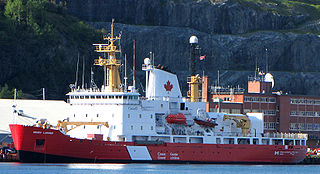
CCGS Henry Larsen is a Canadian Coast Guard Improved Pierre Radisson-class icebreaker serving in the Newfoundland and Labrador region and based in St John's, Newfoundland and Labrador. Entering service in 1988, Henry Larsen is the fourth ship and of an improved design over the rest of the ships in her class. The ship operates in the Arctic Ocean during summer months.

CCGS Louis S. St-Laurent is a Canadian Coast Guard Heavy Arctic Icebreaker. Louis S. St-Laurent's home port is St. John's, Newfoundland and Labrador and is stationed there with other vessels of the coast guard.
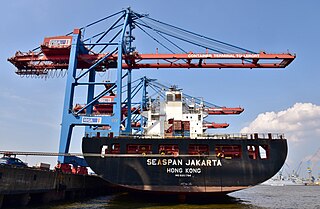
Seaspan ULC provides marine-related services to the Pacific Northwest. Within the Group are three shipyards, an intermodal ferry and car float business, and a tug and barge transportation company that serves both domestic and international markets. Seaspan is part of the Washington Companies, owned by Dennis Washington. Seaspan is run by his son Kyle Washington, as Executive Chairman, who has become a Canadian citizen. Seaspan ULC was formerly known as Seaspan Marine Corporation, and prior to that Washington Marine Group.
The Protecteur class of naval auxiliaries for the Royal Canadian Navy (RCN) began as the Joint Support Ship Project, a Government of Canada procurement project for the RCN that is part of the National Shipbuilding Procurement Strategy. It will see the RCN acquire two multi-role vessels to replace the earlier Protecteur-class auxiliary oiler replenishment vessels that were operated by the RCN.

The Canadian Surface Combatant, formerly the Single Class Surface Combatant Project is the name given to the procurement project that will replace the Iroquois and Halifax-class warships with up to 15 new ships beginning in the mid to late 2020s as part of the National Shipbuilding Procurement Strategy.

Burrard Dry Dock Ltd. was a Canadian shipbuilding company headquartered in North Vancouver, British Columbia. Together with the neighbouring North Van Ship Repair yard and the Yarrows Ltd. yard in Esquimalt, which were eventually absorbed, Burrard built over 450 ships, including many warships built and refitted for the Royal Navy and Royal Canadian Navy in the First and Second World Wars.

Davie Shipbuilding is a historic shipbuilding company located in Lauzon, Quebec, Canada. The facility is now operating as Chantier Davie Canada Inc. and is the oldest continually operating shipbuilder in North America.
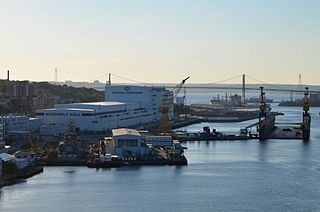
The Halifax Shipyard Limited is a Canadian shipbuilding company located in Halifax, Nova Scotia.

CCGS John G. Diefenbaker is the name for a Canadian Coast Guard icebreaker that had been expected to join the fleet by 2017 but has been significantly delayed. Her namesake, John G. Diefenbaker, was Canada's 13th prime minister. It was Diefenbaker's government that founded the Canadian Coast Guard in 1962.
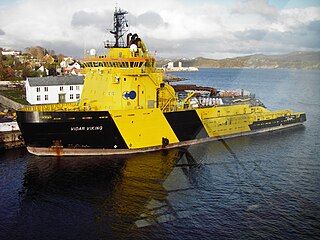
CCGS Captain Molly Kool is a Canadian Coast Guard converted medium class icebreaker. She was originally built as an icebreaking anchor handling tug Vidar Viking for Trans Viking Icebreaking & Offshore in 2001. The vessel was acquired by the Canadian Coast Guard in August 2018 and was commissioned in May of the next year after refit.
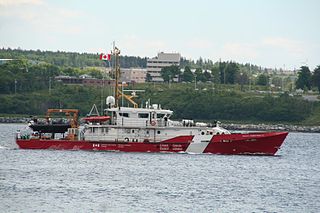
The Hero-class patrol vessels, previously the Mid-Shore Patrol Vessel Project, is a series of nine patrol vessels constructed by Halifax Shipyards for the Canadian Coast Guard. Based on the Dutch Damen Stan 4207 patrol vessel, construction began in 2011 and the first vessel entered service in 2012. The vessels are assigned to both coasts of Canada, used for coastal patrol duties.

The Harry DeWolf-class offshore patrol vessels are warships of the Royal Canadian Navy (RCN) built by the Government of Canada Arctic and Offshore Patrol Ship (AOPS) procurement project, part of the National Shipbuilding Procurement Strategy. In July 2007 the federal government announced plans for acquiring six to eight icebreaking warships for the RCN.
CCGS Earl Grey is a Samuel Risley-class light icebreaker and buoy tender in the Canadian Coast Guard. Constructed in 1986, the vessel serves a variety of roles, including light ice-breaking and buoy tending, as well as being strengthened for navigation in ice to perform tasking along the shores off the Atlantic coast of Canada. Like her sister ship, CCGS Samuel Risley, she carries a large and powerful crane on her long low afterdeck for manipulating buoys. Earl Grey is the second icebreaker in Canadian service to carry the name.

CCGS Jean Goodwill is an icebreaking anchor handling tug supply vessel (AHTS) converted to a medium class icebreaker for the Canadian Coast Guard. She was originally built as Balder Viking for Trans Viking Icebreaking & Offshore AS in 2000. The vessel was acquired by the Canadian Coast Guard in 2018 and was initially expected to enter service in late 2019. However, due to delays the conversion of the vessel is now expected to be completed in late 2020.

CCGS Vincent Massey is an icebreaking anchor handling tug supply vessel (AHTS) being converted to a medium class icebreaker for the Canadian Coast Guard. She was originally built as Tor Viking for Trans Viking Icebreaking & Offshore AS in 2000 and has also traded under the name Tor Viking II. The vessel was acquired by the Canadian Coast Guard in 2018 and was initially expected to enter service in summer 2020. However, the conversion work has been delayed and the delivery date is not known as of July 2020.

Irving Shipbuilding Inc. is a Canadian shipbuilder and in-service support provider. The company owns industrial fabricator Woodside Industries in Dartmouth, Halifax Shipyard as the largest facility and company head office. In addition, the Shelburne Ship Repair for serving small and medium-sized vessels and Halifax-based Fleetway Inc., an engineering and design, support and project management firm.

Project Resolve is the name of a pan-consortium made up of Chantier Davie Canada, Aecon Pictou Shipyard of Pictou, Nova Scotia and NavTech, a naval architectural firm, to develop an interim fleet supply vessel for the Royal Canadian Navy (RCN) until the previously-ordered Protecteur-class auxiliary vessels are complete. As of 2016, the project purchased MS Asterix, a commercial container ship, and is converting the vessel into an auxiliary naval replenishment ship that will be rented by the Royal Canadian Navy. The conversion was expected to be completed and the ship active in service by 2017. In late 2017, Davie proposed extending the project through the conversion of a second ship to ensure full capability for both the Atlantic and Pacific fleets.

CCGS Sir John Franklin is an offshore fisheries research ship of the Canadian Coast Guard. The ship was ordered in 2011 as part of the Canadian National Shipbuilding Procurement Strategy (NSPS) as a replacement for aging Canadian Coast Guard vessels. The ship was launched on 8 December 2017, named for Sir John Franklin, an arctic explorer who led two Royal Navy expeditions in search of the Northwest Passage, the second ending with the death of all his crew around 1848. The first of three vessels, Sir John Franklin is the sister ship of CCGS Capt. Jacques Cartier and CCGS John Cabot.
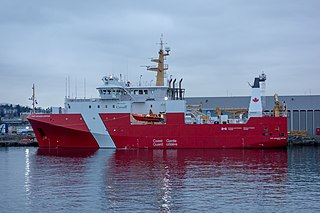
CCGS Capt. Jacques Cartier is an offshore fisheries research ship of the Canadian Coast Guard. The ship was ordered in 2011 as part of the Canadian National Shipbuilding Procurement Strategy (NSPS) as a replacement for aging Canadian Coast Guard vessels. Capt. Jacques Cartier is the sister ship of CCGS Sir John Franklin and CCGS John Cabot. The ship was constructed at Seaspan Shipyard, Vancouver, British Columbia and launched on 5 June 2019.
References
- ↑ "Construction of small vessels". Public Works and Government Services Canada. 14 July 2015. Archived from the original on 16 October 2015. Retrieved 29 November 2015.
- ↑ "National Shipbuilding Procurement Strategy (NSPS)". Public Works and Government Services Canada. 18 November 2015. Archived from the original on 16 October 2015. Retrieved 29 November 2015.
- ↑ "Harper Government Announces Two High-Value Contracts Under NSPS" (Press release). Public Works and Government Services Canada. 10 July 2015. Retrieved 29 November 2015.
- ↑ Pugliese, David (9 March 2021). "PBO at a loss to explain why cost of new Canadian warship, currently at $77B, keeps rising". Ottawa Citizen. Retrieved 7 May 2021– via Saltwire.
- 1 2 "Canada's biggest-ever military procurement at 'very high risk,' documents suggest". CTV News. 20 September 2015. Retrieved 29 November 2015.
- ↑ Cooke, Alex (26 June 2021). "HMCS Harry DeWolf welcomed into Royal Canadian Navy fleet" . Retrieved 26 June 2021.
- ↑ "The Polar Icebreaker Project: A Fiscal Analysis".
- ↑ Blenkey, Nick (22 May 2019). "Canada to build 18 more Coast Guard vessels". MarineLog. Retrieved 8 May 2021.
- ↑ Middlemiss, Dan (17 November 2020). "PBO Releases Cost Comparisons for Canada's Two Supply Ships". Canadian Naval Review. Retrieved 8 May 2021.
- ↑ "Cost of Coast Guard ship nears $1B as questions mount over federal shipbuilding plan". Lethbridge News Now. The Canadian Press. 21 February 2021. Retrieved 8 May 2021.
- ↑ Withers, Paul (6 January 2020). "Rising costs drain contingency fund for Canada's new fisheries science ships". CBC News. Retrieved 8 May 2021.
- 1 2 "Government of Canada announces Polar Icebreakers to enhance Canada's Arctic presence and provide critical services to Canadians" (Press release). Government of Canada. 6 May 2021. Retrieved 7 May 2021.
- ↑ Duffy, Andrew (9 October 2020). "Last of three new coast guard vessels handed over in Victoria". Times Colonist. Retrieved 7 May 2021.
- ↑ "Multi-purpose vessels". Public Works and Procurement Canada. 13 November 2019. Retrieved 12 January 2020.
- 1 2 "Feds plan six new icebreakers for aging Canadian Coast Guard fleet". Nunatsiaq News. 14 August 2019. Retrieved 12 January 2020.
- ↑ "National Shipbuilding Procurement Strategy". Government of Canada. Retrieved 29 November 2015.
- 1 2 Payton, Laura (19 October 2011). "Halifax, BC yards win shipbuilding work". CBC News. Retrieved 29 November 2015.
- ↑ Cudmore, James (16 January 2015). "Canada's navy to get 5 or 6 Arctic ships, not 8". CBC News. Retrieved 29 January 2015.
- ↑ Pugliese, David (3 September 2015). "Work has begun on Arctic Offshore Patrol Ships – first ship to be operational in four years". Ottawa Citizen. Retrieved 29 November 2015.
- ↑ Withers, Paul (1 May 2015). "Ottawa says Irving Shipbuilding will build up to 15 combat ships". CBC News. Retrieved 29 November 2015.
- ↑ "Results of pre-qualification process for Canadian Surface Combatant". Public Works and Government Services Canada. 18 November 2015. Retrieved 29 November 2015.[ permanent dead link ]
- 1 2 Den Tandt, Michael (14 May 2015). "Conservatives' in dilemma over shipbuilding program as election approaches". National Post. Retrieved 29 November 2015.
- 1 2 Seyd, Jane (22 May 2015). "Shipyards on track, Seaspan says". North Shore News. Retrieved 29 November 2015.
- ↑ Cudmore, James (25 November 2015). "Shipbuilding strategy needs work to get ballooning costs under control, ministers told". CBC News. Retrieved 29 November 2015.
- ↑ Gunn, Andrea (26 November 2015). "Hints of shipbuilding shortfall". Chronicle Herald. Retrieved 29 November 2015.
- ↑ Pawson, Chad (8 December 2017). "Ahoy! 1st vessel built under federal shipbuilding strategy unveiled in B.C." CBC News. Retrieved 9 December 2017.
- ↑ Brewster, Murray (5 February 2019). "Ottawa pushes navy's planned supply ships to the front of the construction queue". CBC News. Retrieved 17 February 2019.
- ↑ "Cost of Coast Guard ship nears $1B as questions mount over federal shipbuilding plan". Lethbridge News Now. The Canadian Press. 21 February 2021. Retrieved 22 February 2021.
- ↑ Brewster, Murray (8 February 2019). "Ottawa makes its $60B frigate project official, even as rival's court challenge goes forward". CBC News. Retrieved 17 February 2019.
- ↑ "Government of Canada announces construction of new icebreakers for Canadian Coast Guard" (Press release). Public Works and Procurement Canada. 2 August 2019. Retrieved 12 January 2020– via newswire.ca.
- ↑ "Quebec's Chantier Davie only shipyard to qualify for icebreaker work: Feds". CTV News. The Canadian Press. 19 December 2019. Retrieved 12 January 2020.